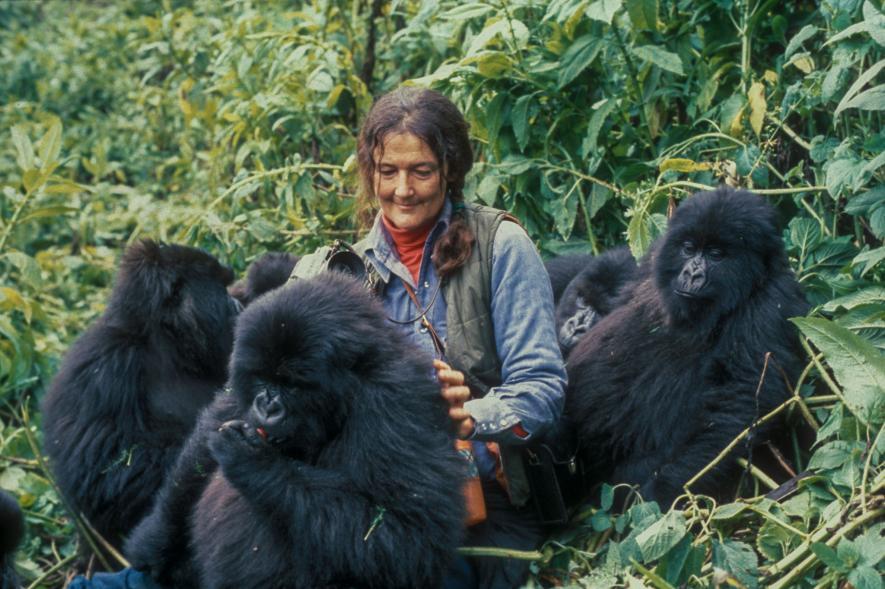Dian Fossey through her gorillas in the mist largely contributed to conserving mountain gorillas from 1967 to 1984. Earlier, George Schaller in 1959 had conducted a pioneer study of these apes that paved the way for the current global attention on conservation of gorilla and their habitats.
From 1902 when gorillas were discovered by a German explorer Oscar Von Beringe to the arrival of Dian Fossey in Rwanda during the 1960’s, the most extensive poaching and habitat loss of mountain gorillas occurred.
While the killing of gorillas was mounting, Dian Fossey began the most extensive research study of gorilla behavior first in DRC and later in Rwanda where she permanently established Karisoke research camp. She began helping gorillas, but the species were almost extinct.
Dian Fossey’s team of locals and research students revealed ecological, social and health life of gorillas during the years she spent in the forests. Few groups of mountain gorillas were habituated so people would get close to gorillas and it helped to portray gorillas as peaceful animals.
Gorilla Habituation and Gorilla Trekking
Gorilla habituation is a process of training gorillas to get accustomed to humans but without changing their natural wild and social behavior. Dian Fossey spent almost 20 years following gorillas and collecting behavior and psychological data. But she had to first learn to imitate their feeding behavior in order to get close to them with no threat and it was successfully done with few groups of gorillas habituated.
She shared her experience with the rest of the world in her gorillas in the mist. It attracted support to habituate more gorilla families to start a new form of gorilla tourism through gorilla trekking which has attracted many tourists generating finances used for conservation activities like anti-poaching.
Today, there are several habituated gorilla families in Bwindi Forest and the Virunga Massif. Today gorilla trekking is a popular activity in Volcanoes National Park in Rwanda, Bwindi Impenetrable Forest in Uganda and Virunga National Park in the Democratic Republic of Congo. Many tourists want to see gorillas at a cost. Gorilla trekking has generated huge income that is helping gorillas to survive.
Gorilla trekking has strict rules and regulations limiting tourist contact with gorillas. A set of environmental rules including limiting sick tourists, keeping 7 meters away when viewing gorillas among others have ensured safety and health of gorillas through gorilla tourism.
Tourists who can afford gorilla trekking are encouraged to trek gorillas in Rwanda, Uganda and DRC. If it was not gorilla tourism, gorillas would be extinct. Financial benefits as an economic incentive are used to empower locals and keep the gorilla habitats off agriculture and other human activities. Visit the tour operators listing for gorilla trekking safaris in Rwanda, Uganda and DRC.
Dian also introduced anti-poaching patrols, removal of snare traps and directly confronting other forms of illegal encroachment on the gorilla habitats in Rwanda. However, her work was much hampered by resistance from locals and threat of civil wars in eastern DRC.
These were the most effective conservation strategies of Fossey’s time that laid foundation for the mountain gorilla project in 1979. Mountain gorillas began to heal and rebound from poaching and habitat loss due to international support for gorilla conservation and research.
As the project began arranging ground work for gorilla tourism development and ecotourism, Dian Fossey was placing hard to finish off her research work at karisoke. She published her book “gorillas in the mist” before her murder in 1984 which set a lasting trend for scientific gorilla research in history of African ape conservation.
Today, the Dian Fossey gorilla fund international stands out for successful mountain gorilla conservation through daily monitoring, education for conservation and most importantly helping local communities living around gorillas in Uganda, Rwanda and DR Congo.
Mountain gorilla national parks are surrounded by high population. These depend on forests for food through hunting, firewood; water collection for their livelihoods.
Hence involving locals in conservation and providing alternative resources was and it is still a major work of the Dian Fossey’s legacy has improved their lives thus striking the delicate balance of conservation and gorilla tourism development.
Gorilla numbers were below 500 individuals at the time of Dian Fossey. As strange as it may sound, there was little or no health monitoring of gorillas as well as weak protective force of wildlife rangers across gorilla range states.


















